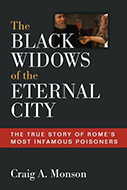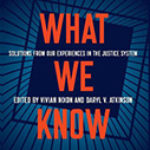The Black Widows Of The Eternal City: The True Story Of Rome’s Most Infamous Poisoners

Author: Craig A. Monson
Publisher: Ann Arbor, MI: University of Michigan Press, 2020. 258p.
Reviewer: Trevor Dean | September 2021
This is an engaging and well-constructed retelling of a notorious episode of husband-poisoning in seventeenth-century Rome; one that also raises some important methodological issues regarding narrative and history.
The author is an early-modern musicologist who segued into crime history via a study of music in female convents (Nuns Behaving Badly, 2010), and then a history of the murder of two abducted nuns (Habitual Offenders, 2017). Those books have been praised for their evocative and imaginative reconstructions, and the current study adopts many of the same narrative techniques.
Monson starts Black Widows at the end of the story, with the hanging of five women in July 1659, before setting out his reasons for retelling their story, and including his sources and methods. His purpose is to retrieve these women from the “lurid” overlay of centuries of popular, true-crime narratives. His sources are the 1,500 decaying pages of testimony kept in the State Archive in Rome, along with other sources such as the records of births, marriages and deaths, or the decisions of the Roman governor’s court. His method is imaginatively to reconstruct the words and actions of the characters, “so as to come closer to what was actually said,” by editing the document and “removing redundancies, combining answers … putting indirect into direct speech” (p. 8).
For the ensuing thirteen chapters, Monson tells the story of the police investigation into the suspicious deaths of numerous husbands spread across the years 1655 to 1659. He aims to “create a kind of seventeenth-century ‘police-procedural’” (p. 5). In Chapter 1 we have the deaths in 1655 of the husbands of two sisters and the husband of their aunt, Elena, and our first meeting with the fatal symptoms which become familiar in the rest of the book — fever, severe stomach-ache, vomiting, and intense thirst. We also first learn of one of the central characters, the distributor of the “special elixir” that delivered these symptoms, Giovanna de Grandis. It is Elena who provides the link to the main events in 1659 (Chapter 2), as she tries to warn Giovanna about the police inquiries. Unheeding, Giovanna falls into a police trap and is taken to jail. Monson paints a sympathetic portrait of Giovanna (Chapter 3), as a thrice-married but indebted woman, reduced to laundering and to peddling “women’s secrets,” and who had already seen the inside of Rome’s jails. Her responses to interrogation lead to the arrest of two more women, migrants from Sicily (Chapter 4), including the woman known as “the astrologer,” who was eventually incriminated as the main producer of the suspect poison. Chapters 5 and 6 take us back to Giovanna, and her further revelations, which lead to more arrests and interrogations of women alleged to have distributed, bought, or used the poison. After a pause to discuss the nature of the poison (Chapter 7), we then hear the statements of these other women drawn into the net: Cecilia, who said that she knew the poison had been used on her own son (Chapter 8), Anna Maria, who confessed to killing her own husband (Chapter 9), a butcher’s wife who did the same (Chapter 11) and another laundress, Laura, who acted as a go-between (Chapter 10). Also here is information about two noblewomen who allegedly obtained the poison (Chapter 12) but were not followed up by the investigator, Lieutenant-Governor Stefano Bracchi. Finally (Chapter 13), Monson describes the repeated and fruitless encounters between Bracchi and the ringleader, Gironima Spana, who successfully denied or deflected all the questions and testimony against her. And so the account comes back to its starting point — the execution of five of these women, a moment poignantly told using the records of the confraternity that comforted convicts on their procession to the scaffold (Chapter 14). Two further chapters track a follow-up investigation (another confession, another death penalty, though this time commuted to exile) and the fates of some women who were incriminated but not convicted.
Monson states explicitly that he is directing his retelling of these events “toward general readers rather than a specialist audience” (p. 4), and with that aim it is a great success. Despite a large cast of characters (several of whom bear the same forename) the narrative is clear and colourful; maps and photographs facilitate visualisation of the physical setting; and he borrows from some works of microhistory a recreation of the point-of-view of subaltern actors held in the gaze and grip of judicial power. He also performs a useful corrective to the continuing “lurid” popular versions of this crime. Striking are the author’s portraits of the purchasers of the “special elixir” — in unsatisfactory or abusive marriages, to husbands who squandered their dowries, battered them, or had affairs with boys. They must have viewed a poison marketed as untraceable – none of the medics who treated the victims seems to have suspected poison – as an attractive solution.
Specialists (as Monson probably suspects) might want more and want different, though he does provide frequent footnote references to the archival documents, he rarely quotes the Italian or Latin which is translated with such immediacy in the text. There is a risk too of specialists feeling uncomfortable with the distance between the novelistic methods and the archival evidence (insofar as we can see it). Moreover, in turning conversations reported in an interrogation room, with its obvious power imbalances, into direct conversations between historical actors, he does not fully take account of that branch of discourse analysis concerned with the construction and manipulation of speech in interrogations. The characterisation of the investigator’s methods – withholding information, selective questioning, undermining resistance (p. 45) – only takes us part of the way there, and nods rather vaguely to “modern-day counterparts.” The frequent imputation of thoughts, expressions and feelings to the main characters, especially to the investigator and his chief suspects – “Bracchi raised an eyebrow”, “Bracchi remained impassive”, “Gironima smiled with confidence”, “surely Gironima has long wondered” (pp. 127, 133, 153, 157) – are good narrative devices that improve readability, but should not be relied on. What is interesting, from a character-writing point of view, is the way that Monson creates an investigative personality for Stefano Bracchi, whom he describes, for the lack of readily-available information about him, as a “faceless bureaucrat” (p. 38). He is at turns expeditious, aggressive, exasperated, downcast, suspicious, and impulsive, but above all he is in control, measuring his techniques and seizing his moments. Monson makes him into a believable character — but is he believable because we have read so many detective stories with heroes who are like him? Is there a tension here between the believability of Bracchi and Monson’s sympathy for the widows? Yet this could be one further element of readability; reader sympathies are divided between a recognisable investigator, who nonetheless tortures and sends women to the gallows, and ill-married women who nonetheless commit homicide. Is either excusable?
Trevor Dean, Professor Emeritus, University of Roehampton, London UK


